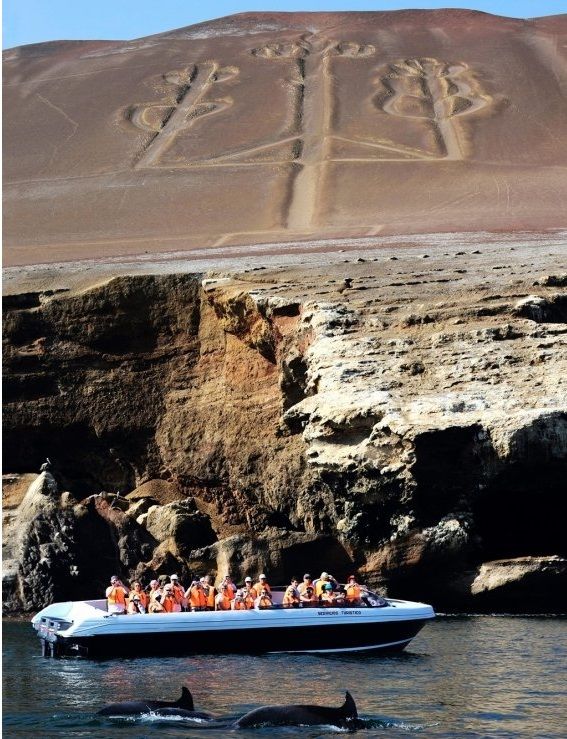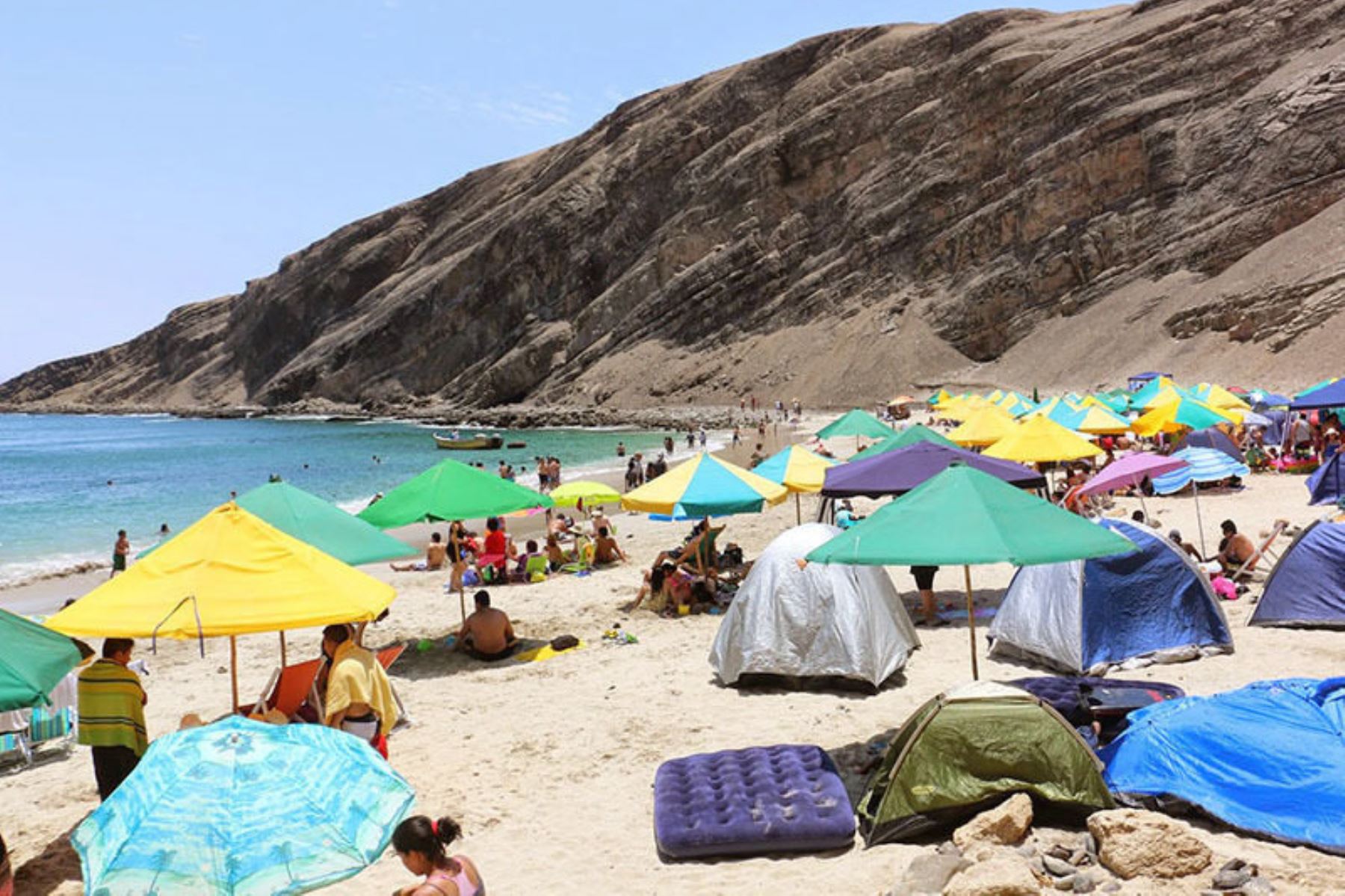Paracas is located in the department of Ica and the province of Pisco in Perú.
Due to its proximity to the sea, Paracas is a spa in the shape of a bay. The attraction of this resort is its climate, beach and beautiful residences built there.
The name of Paracas means “sand rain” because in this place the winds are carriers of sand; these winds can reach a speed of 32 km per hour.
Paracas in Perú covers an area of 335,000 hectares, of which 117,406 are on land and 217,594 on marine waters.
Paracas in Perú has been declared a regional reserve for migratory birds.
Visitors to Paracas like to observe the different ecosystems, the archaeological remains of the Paracas culture, the place where San Martín landed and the great diversity of marine fauna existing in the area.
Weather in Paracas Perú

paracas_candelabro 
paracas beach
The climate is typical of the desert with temperatures above 30 ° C, and in winter, the temperature drops to 10 ° C at night.
Paracas National Reserve
The Paracas National Reserve is one of the two Protected Natural Areas that preserves representative samples of the country’s marine-coastal ecosystems, providing protection to various species of flora and fauna that live in that area. Animals such as sea lions, Humboldt penguins, dolphins, flamingos among others live in this fascinating maritime area.
Within the tour of the Paracas National Reserve it is possible to observe El Candelabro, a geoglyph located northeast of the Paracas bay and that can be admired in its entirety from the sea by the Ballestas Islands. The traveler also has the possibility of visiting the Cathedral, a rocky structure produced over time by the sea and the wind, it has a concave shape similar to the dome of cathedrals.
Location
The Paracas National Reserve is located in the province of Pisco, within the department of Ica. The Paracas National Reserve was declared as such on September 25, 1975. It was created in order to conserve a portion of the sea and the desert of Peru, giving protection to the various species of flora and fauna that live there.
How to get to the Paracas National Reserve?
The Paracas National Reserve is located 250 km south of the city of Lima, taking the Panamericana Sur highway, the main access road with a paved track, either through the city of Pisco and along the coastal avenue that crosses through the town of San Andrés, or taking the direct detour to the town of Paracas (without having to cross both urban centers).
Another form of access is by sea, through the San Martin port, located in Punta Pejerrey on the Paracas peninsula. Due to the characteristics of the area, which is a wide and open desert, access to the reserve can be given from anywhere, either by car with 4 × 4 traction or on foot through the desert, or by sea by boat landing on any beach.
The best way to get to the Paracas National Reserve is a full day tour to Paracas Reserve.
Fauna
The Paracas National Reserve has favorable environments on the coast for the conservation and quiet reproduction of numerous species of resident and migratory birds.
Among the most common are the pelicans, the gray gull (Larus modestus), the tendril (Larosterna inca), the skimmer (Rynchops nigra), the arctic plover (Pluvialis squatarola), the chuita (Phalacrocorax gaimardi), the guanay (Phalacrocorax bougainvilli), the condor, the Humboldt penguin (in danger of extinction) and the parihuanas or flamingos (Phoenicopterus chilensis), among other species.
The fish found in this maritime zone are: sole (Etropus extenes), white toyo (Mustelus whitneyi), bonito (Sarda chilensis), tramboyo, ray, cheetah, sardine, anchovy Engraulis ringens, pampanito, grouper, corvina, lorna and many other species.
The mammals in this reserve are mainly represented by the one-haired sea lions (Otaria byronia), the two-haired wolf (Arctocephalus australis), the bufeo (Delphinius delphis) and the sea cat (Lontra felina). this one, in danger of extinction.
The reserve is also populated by leatherback and green turtles, reptiles such as lizards (Microlophus spp.) And geckos (Phyllodactylus spp.), Octopus, squid (Loligo gahi), clams and crustaceans such as the carter (Ocypode gaudichaudii), the purplish crab ( Platyxantus orbigny) and the muimuy (Emerita analoga).
Flora
This part of the Pacific Ocean is rich in phytoplankton and algae. According to the investigations carried out in situ, more than 250 species of algae have been counted, such as the weeds (Gigartina chamissoi and Grapeloupia doryphora), the sea lettuce (Ulva fasciata forma costata), and the aracanth (Macrocystis integrifolia).
The terrestrial flora has few species, due to the extreme aridity of the desert. However, there are areas in the desert, called lomas, which receive a constant supply of coastal fogs, in which small communities of lichens, tillandsias, and some herbs develop (among the most common are the species of Solanum and Oxalis).
The northern part of the Reserve includes large areas covered by Distichlis spicata and a small forest of sofaique (Geoffroea decorticans).
What to see in the Paracas National Reserve?
The chandelier
The chandelier, located northwest of the Paracas Bay, is a geoglyph (channels or lines engraved in rock) that has an extension of 120 meters, which is also called Tres Cruces or Tridente.
The chandelier is engraved in cream colored rock, but mostly covered with sand. The sand never completely obliterates the chandelier due to the winds that are always removing excess sand from the channels. (photo shows with cream rock with sand)
The Paracas chandelier is believed to be related to the Nazca and Pampas de Jumana lines and geoglyphs.
The best way to appreciate this geoglyph is from the sea and tours to the Ballestas Islands always pass and stop for a few minutes so that tourists can take their photos.
Cathedral
The cathedral is a rock formation caused by the erosion of the sea and the wind. It has a concave shape that is reminiscent of the domes of cathedrals.
It is located between the Yumaque and Supay beaches.
Some sea cats or chingungos live inside the cathedral, as well as some sea birds.
Interpretation Center of the Paracas National Reserve
To understand the importance of the Paracas National Reserve, you can visit its interpretation center. This offers an interesting explanation of the biodiversity and the dangers that the area faces.
Julio C. Tello Museum
The Julio C. Tello site museum presents a permanent exhibition of the pieces of the Paracas culture found in the excavations of the cemeteries in the area. The museum’s hours of operation are Tuesday through Sunday (including holidays) from 9 am to 5 pm.










